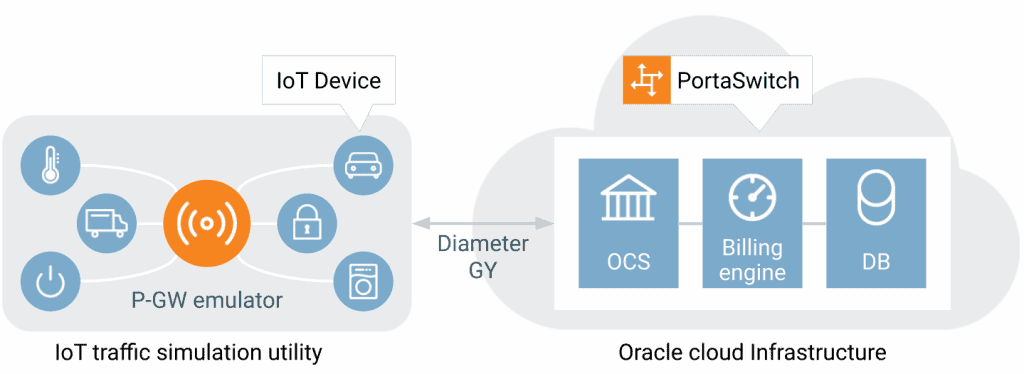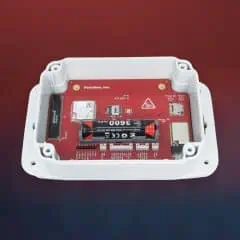Tests prerequisites
Arqia, a Brazilian MVNO that provides IoT and M2M solutions, uses PortaBilling to provide charging and billing capabilities of its IoT services. The PortaBilling solution is deployed in the Oracle Cloud environment in a Sao Paulo datacenter. With plans to expand the number of IoT SIM cards to 1.5 million, Arqia was unsure about the cloud solution capacity and stability to handle the expected traffic increase.
PortaOne approach
The testing process started with the evaluations of the transaction traffic volume on PortaBilling. Based on the target number of SIM cards and value for IoT device reauthorization time (25 minutes), PortaOne calculated the need to support 1000 transactions per second (TPS) via PortaBilling.
To conduct the tests, PortaOne developed a software utility that simulated the traffic created by IoT devices by defining the workload with the required number of TPS. The software utility emulated the behavior of IoT devices connected to the telco-grade P-GW solution by sending billing requests to the PortaBilling solution through the Diameter Gy protocol.
The tested PortaBilling solution contains a cluster of billing nodes. Each node collects all real-time requests from all the network components providing the services and performs AAA of the subscribers through RADIUS or Diameter protocols. Using an additional node increases system performance. Also, PortaBilling includes a MySQL database configured to enable main-secondary data replication. A monitoring system tracked the workload on PortBilling by measuring the load of the CPU and runtime memory of each node. PortaOne monitored the time between sending a request by a software utility and receiving a response from the PortaBilling. The maximum load on the PortaBilling was determined when the time took more than 5 seconds.

PortaOne performed the test in four different configurations of PortaBilling, using 1, 2, 3 and 6 billing nodes respectively. This approach targeted two goals. First, PortaOne had to identify the minimal amount of billing nodes needed to handle 1000 TPS, as was required by Arqia. Second, PortaOne was aiming to identify PortaBilling’s scalability capabilities when changing the amount of billing nodes.
Test results
The table below represents the test results.
| The number of billing nodes used in PortaBilling | Transactions per second processed by PortaBilling | Increased performance of PortaBilling solution compared to single-node solution performance, times |
|---|---|---|
| 1 | 375 | |
| 2 | 740 | Х 1.97 |
| 3 | 1100 | Х 2.93 |
| 6 | 1750 | Х 4.67 |
A minimal amount of billing nodes. This shows that the PortaBilling solution can be easily configured to handle a wide range of required traffic loads. PortaBilling’s performance of 1000 TPS was reached by using three billing nodes in the cluster.
The number of supported IoT devices. It is determined by the product of the number of processed transactions by the device’s connection period until it is re-authorized in the IoT provider network. By changing this re-authorization time period, an IoT provider can vary the number of supported IoT devices. The re-authorization time depends on the actual IoT use case to be provided to end customers.
| The number of billing nodes used in PortaBilling solution | Number of supported IoT devices for different reauthorization periods, mln of devices: | |
| reauthorization period 25 minutes | reauthorization period 2 hours | |
| 1 | 0.56 | 2.7 |
| 2 | 1.11 | 5.33 |
| 3 | 1.65 | 7.92 |
| 6 | 2.63 | 12.6 |
Solution scalability. The test has shown that the capacity of the PortaBilling cloud solution is easily scalable due to the possibility to utilize different number of billing nodes. Additionally, the tests have shown that database performance decreases with increasing load. For example, when using six bIlling nodes, the productivity of the entire PortaBilling solution increases only 4.67 times. This is because the MySQL database performance becomes a bottleneck of the entire system. To overcome this limitation, it is necessary to select a cloud shape for the MySQL database configuration capable of processing bigger loads.
Test benefits
The tests ensured that telecom operators can rely on both PortaOne and Oracle to run their business applications in a cloud environment. This applies even to critical business applications, such as charging and billing.
The Communication Service Providers will benefit from using the PortaBilling solution deployed in the Oracle cloud environment in multiple ways:
- The CSPs can achieve the required performance level from the PortaBilling solution deployed on Oracle Cloud;
- PortaOne can easily scale the solution according to the telecom provider needs to support the number of supported IoT devices;
- Migrating their business applications to the cloud is a safe and cost-effective solution for telecom providers. PortaOne has a proven solution to support that move.


















